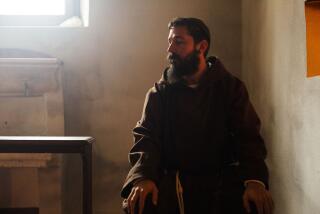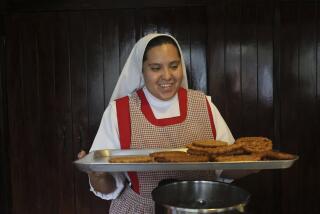Old Order Welcomes Arrival of a New Day
- Share via
Brother Theodore Smith, dressed in the white habit of a Norbertine priest, was strolling through St. Michael’s Abbey in El Toro, discussing the vow of celibacy, when a blast of rock and roll from a nearby radio interrupted him.
“We are living in the material world, and I am a material girl,” sang pop star Madonna. The teasing refrain all but drowned out Smith’s words, and he paused while an embarrassed student in the abbey’s high school turned off his radio.
It was a telling moment at the rustic religious retreat, where a handful of priests and seminarians have upheld the 800-year-old traditions of the Norbertine Catholic order since the abbey opened in 1961.
For years, the little-known, hillside settlement has been left to itself, an anomaly amid Orange County’s booming growth. Members of the order have pursued their goals of a reclusive spiritual life and an active preaching of the Gospel in relative peace and quiet.
Today, however, there are unmistakable signs that the material world is creeping up on St. Michael’s.
The area’s early morning tranquility, once highlighted by the singing of 6 a.m. prayers at the abbey, is now interrupted by jackhammers, bulldozers and trucks across El Toro Road, where 940 housing units are going up.
Transportation officials plan to widen the sleepy roadway curving around St. Michael’s to accommodate an expected glut of cars. Down the road, developers are readying plans for a shopping center and office complex.
The hustle and bustle is a far cry from St. Michael’s early days when, priests said, they carried water by hand from mountain wells and made trips over bumpy roads to Santa Ana, 25 miles away, to buy food and supplies.
Leaders of the abbey, however, said they welcome these changes.
“We don’t mind it, we support it,” the Rt. Rev. Ladislas K. Parker said of the developments. “Change here was inevitable. We knew it all along.”
Parker, 69, the white-haired patriarch of St. Michael’s, explained that the abbey’s church will gain parishioners as homes fill the area. New growth also will bring students to St. Michael’s high school, he said.
Parker said he also welcomed the new subdivisions because St. Michael’s finally will be able to connect to a modern sewage system and won’t have to rely on septic tanks.
“I’m very anxious to be able to tie into the development around us,” he said. “The (construction) companies have assured me that we’ll be the first ones to benefit.”
For Parker, the changes are just another chapter of the abbey’s 24-year history.
He and six other Norbertine priests established the El Toro abbey after a harrowing 1950 escape from their Hungarian homeland, where Communist authorities suppressed the Norbertine sect. Parker said he and the priests had to elude armed guards and swim across a 60-foot river at night to escape across the Austrian border.
“Stalin booted me and my fellow priests out of our country,” he said. “It was a very dangerous time, and a difficult thing to preserve our traditions.”
The priests sailed to America and worked for several years at a Norbertine retreat in Wisconsin. Then Cardinal James Francis McIntyre of Los Angeles allowed them to establish the first Norbertine settlement on the West Coast. Today, the Orange County order is one of three such communities in the nation. The third is in Pennsylvania.
In keeping with the traditions of the Norbertine order, founded by St. Norbert in 12th-Century France, St. Michael’s leaders stress the goals of a contemplative life. Silent meditation, for example, plays a key role in the abbey’s solemn rituals.
But the order also emphasizes the need to preach the Gospel and reach out to the surrounding community. The abbey runs a summer camp for boys between the ages of 6 and 12, and several of its 21 priests teach at Mater Dei High School in Santa Ana.
The heart of St. Michael’s, however, lies in its hilltop church, boys’ high school and seminary, which prepares young men for the priesthood. Each has a part in the abbey’s daily life.
For Father Phillip Smith, 26, the day begins at 6 a.m. with quiet prayer and a choral Mass. In the early morning light, he and other priests stream into a hushed wooden chapel, celebrating their faith with gentle, lilting voices.
It is a ritual that Smith described as “comforting and strengthening . . . . It’s the service of Christ, the service of the church. We sing these prayers three times a day.”
The rest of the day, Smith teaches in the high school, gives Latin and Italian lectures at the seminary and studies privately for hours. The day ends with evening prayers at 9 p.m. One hour later, the abbey is almost silent.
“Everyone remarks on the peace out here, how still it seems to be,” said Smith, a Fullerton native whose elder brother, James, is also a priest at St. Michael’s.
“I remember visiting here when I was 6, 7 years old . . . from my youngest years I knew about St. Michael’s.” It was, he said, “a natural place for me to think of, when I realized in high school that I’d like to become a priest.”
Ordained Last June
Smith studied for seven years before he was ordained last June. The route to St. Michael’s included several years in a community college, a novitiate year at the abbey, and four years of theological study in Rome.
Reflecting on the changes around the abbey, Smith conceded that his colleagues “like being a little bit away from the city. And not everyone is happy about the way our landscape is being marred.
“But I for one welcome it. I see that St. Michael’s could very well become a center for the Catholics of the area. Right now, we have a number of people who come out here for Sunday Mass, but they drive quite a distance. I think it will be nice when we are a local church.”
For Matt Mallon, 19, a senior at St. Michael’s live-in high school, the abbey’s isolation is a mixed blessing.
Like his fellow students, Mallon is clean-cut, well-dressed and deferential to his teachers. He typifies the “respectful, well-behaved” ideal that Parker said is central to the school.
The students live in a dormitory during the week, attending morning and evening classes. Instruction is strict, Mallon said, but since “you are forced to study, you take it seriously, and so you have a lot better chance of getting into college.
“They (teachers) don’t sit down and point a gun at your head, but it’s like you have the time to study, so you’re either going to study or just sit there.”
Students also have cleanup chores and curfews, which they monitor themselves. “Nobody here tells us to do these things. We make sure they happen by ourselves,” Mallon said.
But life at St. Michael’s has drawbacks.
Mallon, a Long Beach resident, said he misses his girlfriend, whom he sees only on weekends, and that students are not allowed to make phone calls at night to their friends.
“I have a lot of friends in public schools and it’s really different up here,” he said. “Here you’re really sheltered. It’s very hard to deal with sometimes at night.”
No Plans to Return
Mallon said he respects the discipline he has learned at St. Michael’s but looks forward to graduation in two weeks. He plans to study business administration in college and has no plans to return to the abbey.
The pace at St. Michael’s is “too quiet, too slow,” he said. Further, Mallon said he doesn’t want to live by the requirements of Norbertine life, such as celibacy.
“For them (priests) it might be great. But I can’t see it in my future,” he said.
Brother Theodore Smith, 25, three years into his training at St. Michael’s, is different.
For him, the vows of poverty, chastity and obedience are the essence of a life devoted to God.
“I think it is a gift from God to recognize that the religious life is a very beautiful form of life, and I’m very happy here,” he said. “The Lord says, ‘My burden is light, my yoke is light,’ and it’s so true.”
Smith, whose parents live in Mission Viejo, said he chose the religious life because of the “wonderful example” shown by several teachers at his Catholic high school in Ventura. He has six more years of study before he becomes a Norbertine priest.
Giving up material goals was easy, Smith said, because “I experienced some of that when I was younger . . . every time I went after something like a motorcycle, then when I got it I wasn’t happy with it. I wanted something bigger and better.
“Eventually I found that the real consolation in my life was prayer, and that helped me. It weaned me from the material things, and I’m thankful for that.”
Smith said he was attracted to the Norbertine order because of its strict adherence to tradition and obedience. He described himself as a “very conservative” person, and criticized the lack of such traditions in American life today.
“One of the problems with America is that there is a lot of materialism,” Smith said. “It’s always there; it’s because of original sin. It’s in our very beings. There’s no real sense of obedience to higher principles, and that I think is very important.”
As for the vow of celibacy, Smith said he has overcome the “temptations” of American mass culture. Happiness is possible without a mate, he said.
‘Impurity at a Young Age’
“Because of the really bad examples we get on television and in a lot of the media, it’s possible for people to fall into impurity at a young age,” he said.
“They can really be chained, you know, shackled to the extent that they just don’t see the possibility of living out the vow of celibacy.”
Smith, who lives in a hillside house with other seminarians, added that the rules of the order allow him to listen to recorded music only between 6:15 and 6:45 p.m., and then only in a common recreation area of the home.
“I would say we do have some criteria as to what we listen to,” he added. “Some of the music is suggestive, sexually suggestive, and we can’t condone that. We can’t listen to that. It’s part of the commitment we have made to this life, and to St. Michael’s.”
Parker echoed Smith’s insistence on obedience, discipline and faith as “the key” to spiritual life at the abbey. But he stressed that St. Michael’s also intends to remain deeply involved in the community around it.
On June 16, for example, the order is planning a Father’s Day celebration that will be open to the public. The festivities, from noon to 4 p.m., will include a steak dinner, booths and games for children and a sweepstakes drawing for a grand prize.
As bulldozers and jackhammers tore into hillsides across the road, Parker expressed confidence that St. Michael’s would thrive in a changing world. Smiling, he said in lilting German:
“Zum Guten alten festhalten, und vom Neuen auch nicht ganz abweichen.”
And then he translated: “Hold steadfast to that which was good in the old ways. But do not shy away from the new, which represents true progress.”
More to Read
Sign up for Essential California
The most important California stories and recommendations in your inbox every morning.
You may occasionally receive promotional content from the Los Angeles Times.









